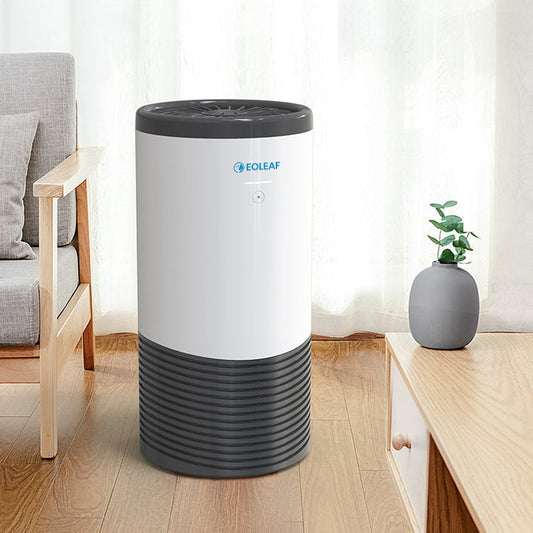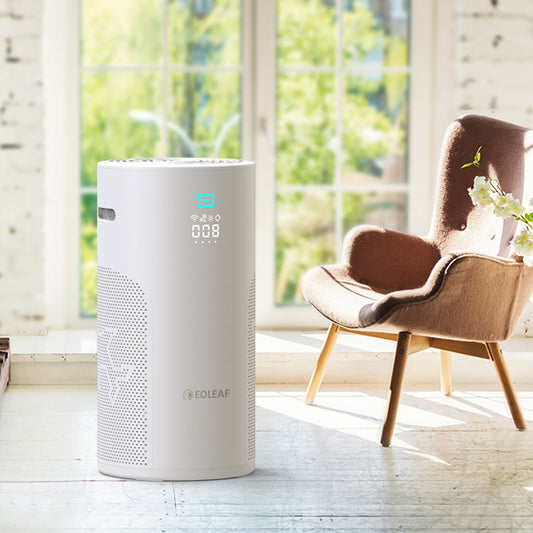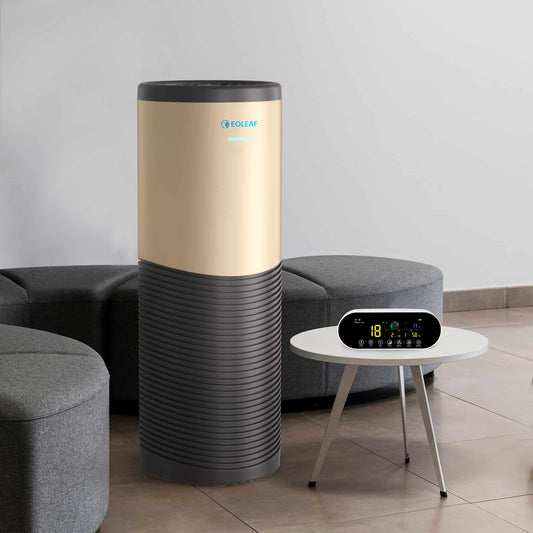How do HEPA filters work?
“HEPA”, or "high-efficiency particulate air”, is widely considered to be the gold standard of air filtration in the air purification world. Many consumers search out the HEPA certification when buying an air purifier because it is a guarantee of effectiveness, especially when it comes to the removal of fine particles from their indoor air. What, exactly, is a HEPA filter? What is the HEPA standard? How does it work? Read on to learn more.

HEPA H13 filters – what are they?
As defined by the NIOSH (United States National Institute for Occupational Safety and Health), a HEPA-certified filter removes 99.97% of particles of a size greater than or equal to a diameter of 0.3 µm1. A filter only receives HEPA certification if it attains this performance in one, single pass. HEPA is a European certification overseen by European standards EN 1822 and EN ISO 29463.
A “DOP” (Dispersed Oil Particulate) test must be passed in order for a filter to obtain HEPA certification. In order to assess the filtration rate of a device, this technique uses oil particles (0.3 µm). When the device passes the test, it is then categorised into one of the following five classes of HEPA filters:
- H10
- Filtration rate: 85%
- Allows 15,000 particles of 0.1 micron per litre of air to pass through
- H11
- Filtration rate: 95%
- Allows 10,000 particles of 0.1 micron per litre of air to pass through
- H12
- Filtration rate: 99.5%
- Allows 500 particles of 0.1 micron per litre of air to pass through
- H13 (as used in Eoleaf products)
- Filtration rate: 99.95%
- Allows 50 particles of 0.1 micron per litre of air to pass through
- H14
- Filtration rate: 99.995%
- Allows 5 particles of 0.1 micron per litre of air to pass through
The filters in Eoleaf products are exclusively HEPA H13 filters. Although there are slightly more efficient filters such as the HEPA H14 (an increase of 0.05% efficacy) or ULPA filters, these filters significantly slow down the flow of purified air. They make sucking in droplets and aerosols in a quick and efficient manner more challenging. These filters are only used in the hospital environment (in operating rooms, for example). The slight gain in efficiency comes at the cost of much slower air treatment. The slowed air flow generally makes them counterproductive.
HEPA filters have been used for decades in various medical settings: laboratories, operating rooms, and cleanrooms. Nowadays, they serve much more diverse purposes in our daily lives: they can now be found in some vacuum cleaners and in cars.

HEPA-certified versus ‘HEPA-type’ filters
Buyer beware! It is becoming more and more common to see the HEPA acronym on the internet or on packaging for air purification products that are not HEPA-certified. You may find phrasing such as ‘HEPA-type’ or similar. Unfortunately, these products are designed to attract customers and fool them into thinking that their filters have the same capabilities as HEPA-certified filters. HEPA-type products have not been certified by third-party organisations, making their efficiency suspect at worst and unverified at best.
Despite the fact that they do not meet the EN1822 European standard, ‘HEPA-type’ filters may still be able to filter out 99% of particles of a size greater than or equal to a diameter of 0.2 µm. Although this may seem like an impressive number at first glance, it is important to keep in mind that HEPA-certified filters can filter out particles much smaller than that, all the way down to a size of 0.01 µm. It is these ultrafine and nanoparticles that are particularly detrimental to human health.
Busting the 0.3 μm myth
You will find articles and blogs that claim that HEPA filters do not filter out particles smaller than 0.3 microns (μm). This wrongful assertion has been spread due to a lack of research and fundamental misunderstanding of the way HEPA filters work. Let us help to set the record straight.
Minimum Efficiency Reporting Values, or a MERV rating, refer to a filter's ability to capture larger particles between 0.3 and 10 µm. As shown by the chart below, the higher the MERV rating, the better the filter is at trapping specific types of particles. The European HEPA standard uses 0.3 μm particles as a reference during their certification procedures to measure the effectiveness of the devices being put to the test. It uses 0.3 μm as the testing size because particles of this size are the most difficult to filter (referred to as MPPS, ‘the most penetrating particle size’)2. Although it might seem counter-intuitive, particles of 0.3 μm are actually harder to filter than smaller particles. This has a simple explanation (more on this below in the paragraph on “How does a HEPA filter work?”): these particles are small enough to pass through most filter’s mesh, but still big enough to pass through the filter as a result of velocity (which is proportional to the mass). A perfect combination. For context, 0.3 microns is about 300 times smaller than the diameter of a single strand of human hair.
In summary, the European standard EN 1822 has rightfully based its tests on the size of 0.3 μm not because it is the minimum filtration size, but because it is the most difficult size to filter. Thus, this standard is guaranteed to test and certify the minimum efficiency, based on the worst possible scenario.
| MERV Rating | Air filter traps particles sized 0.3 to 1.0 microns | Air filter traps particles sized 1.0 to 3.0 microns | Air filter traps particles sized 3.0 to 10 microns | Filter Type & Particles Removed |
|---|---|---|---|---|
| MERV 1 | <20% | <20% | <20% |
Fiberglass and Aluminum Mesh pollen, dust mites, spray paint, carpet fibers, pet dander |
| MERV 2 | <20% | <20% | <20% | |
| MERV 3 | <20% | <20% | <20% | |
| MERV 4 | <20% | <20% | <20% | |
| MERV 5 | <20% | <20% | 20 - 34% |
Disposable Filters mold spores, kitchen aerosols, hair spray, furniture polish, household cleaning sprays |
| MERV 6 | <20% | <20% | 35 - 49% | |
| MERV 7 | <20% | <20% | 50 - 69% | |
| MERV 8 | <20% | <20% | 70 - 85% | |
| MERV 9 | <20% | >50% | 85% or more |
Home Box Filters lead dust, flour, auto fumes, welding fumes |
| MERV 10 | <20% | 50 - 64% | 85% or more | |
| MERV 11 | <20% | 65 - 79% | 85% or more | |
| MERV 12 | <20% | 80 - 90% | 90% or more |
Commercial Filters bacteria, wildfire smoke, respiratory droplets |
| MERV 13 | >75% | 90% or more | 90% or more | |
| MERV 14 | 75 - 84% | 95% or more | 95% or more | |
| MERV 15 | 85 - 94% | 95% or more | 95% or more | |
| MERV 16 | 95% or more | 95% or more | 95% or more | |
| MERV 17 | 99.97% | 99% or more | 99% or more |
HEPA and ULPA viruses, fine particles and ultrafine particles |
| MERV 18 | 99.997% | 99% or more | 99% or more | |
| MERV 19 | 99.9997% | 99% or more | 99% or more | |
| MERV 20 | 99.99997% | 99% or more | 99% or more |
Source 3
A study performed by NASA in 2016 demonstrated that HEPA filters are very effective in particle-capturing of many sizes. They capture a high percentage of nanoparticles as well as particles larger than 0.3 μm, from the biggest particles all the way down to a size of 0.01 μm4.
Additionally, HEPA-certified filters have been certified, meaning they were tested by third parties to ensure their efficacy. This is very rarely true of ‘HEPA-type’ filters.
Which types of pollution do HEPA filters filter out?
HEPA filters are known for capturing a wide variety of air pollutants, particulate and biological pollution in particular. These superior filters are capable of filtering all fine particles (down to PM0.01), germs (bacteria, viruses, mould, and spores), and allergens (pollen, dust mites).
A multitude of studies have been performed focusing on the effectiveness of HEPA filters. One study found that in the presence of burning candles and incense, both sources of particulate matter (also known as PM or fine particle pollution), the use of a HEPA filter reduces PM concentration dramatically. The study recommends use of HEPA filtration to ward off the negative health effects caused by PM (like respiratory disease, cardiovascular disease, and multiple types of cancer), especially PM2.55.
Another study emphasises the benefits of removing allergens and fine particle pollution from indoor air as a means of reducing chronic air pollution-related disease symptoms, especially asthma and cardiovascular disease. The study goes even further to suggest that the use of an air purifier with a HEPA filter can prevent disease progression across all age groups6.
A final study funded by the French government during the COVID pandemic validated the effectiveness of air purifiers using a HEPA filter in eliminating COVID from the air with an efficiency of 99.9%7.

HEPA filter limitations
Albeit serving as an excellent way to trap a wide variety of fine particles, HEPA filters are not perfect all-in-one solutions. They are unable to remove volatile organic compounds (VOCs) because they tend to bounce off the filter’s fibre media. They also are incapable of removing ground-level ozone from the air because ozone is a very small and simple molecule that does not stick to HEPA fibres. Finally, if they capture germs, they are not able to kill them because they do not have sterilising capabilities. That is why it is important to buy a device that combines a variety of filtration technologies, including a HEPA filter.
At Eoleaf, our filters contain 8 different purification technologies. We use an innovative multi-layer technology that is designed in a way that allows each layer to compensate for the weaknesses of the previous layer. This ensures a very broad spectrum of action against all forms of pollution. We use several technologies that fight VOCs and ozone (in particular, our activated carbon filters and photocatalysis technology) as well as germs (UVC sterilisation).
How does a HEPA filter work?
HEPA filters have a similar composition to FFP2 masks with their various intermingled natural fibres. FFP2 masks filter at least 94% of aerosols, as well as particles with an average diameter of 0.6 μm (with a variation of 0.1 to 1 μm). Therefore, HEPA H13 filters offer significantly better filtration than a FFP2 mask.

HEPA filters can intercept particles using four different filtration mechanisms:
- Inertial impaction
- The fibres of the filter pick up particles and droplets that are large enough, notably those larger than 1μm.
- These larger air particles embed directly into the fibres of the filter.
- Direct interception
- The Van der Waals force, otherwise known as the intermolecular force of attraction, intercepts particles and droplets larger than 0.1 μm.
- These particles pass through the filter as they are sucked in by the air purifier and stick to the filter’s fibres.
- Brownian diffusion
- Particles of a size of less than 0.1 μm (like aerosols), some of the smallest known particles, have a so-called Brownian trajectory (a random movement pattern).
- This makes them easy to capture via the Van der Waals force when they strike against the fibres of the filter.
- In a HEPA filter, when the molecules that are smaller than 0.1 micron in size collide with each other, they are slowed down.
- Brownian diffusion further lengthens the time molecules take to pass through the filter, thus increasing their chances of being captured.
- Electrostatic forces
- These are attraction forces that draw viral aerosols to the filter fibres where they are then captured via the previous mechanisms.
It is worth noting that Eoleaf air purifiers come equipped with pre-filters in addition to their HEPA H13 filters, as shown below. Pre-filters trap larger particles before any of the other filtration technologies jump into action, ensuring a longer lifespan for your air purifier’s filter.

Maintaining a functional, efficient air purifier with Eoleaf
As air purification experts, we fully understand how products on today’s air purification market can vary in quality and, thus, price. Our products have been curated keeping high quality and efficiency in mind during every step of the design process.
To provide an example, many manufacturers only provide information to the consumer on the theoretical efficiency of an air purifier’s filter but not the efficiency of the entire device. Lower-cost air purifiers commonly let air seep through small gaps between the filter and the device. This is a manufacturing defect: consequently, not all of the air passes through the fibres of the HEPA filter and some escapes through the small gap without having been filtered.
Therefore, the efficiency of an air purifier greatly depends on how the HEPA filter is integrated and on the quality of the device’s build. Here at Eoleaf, we ensure that there are no leaks between the filter and its housing during the manufacturing process, nor leaks between the housing and the air purifier itself.
Filter replacements
The importance of replacing your filters at regular intervals cannot be understated! If the air purifier is not regularly maintained, it loses its effectiveness and can become a source of air pollution itself. A filter that is saturated with pollutants cannot and does not protect you from air pollution. Furthermore, it can release pollution into the surrounding air.
Here are a couple of tips for maintaining your filters and keeping your device in optimal working order:
- Your pre-filter usually needs to be cleaned once a month.
- Your filter needs to be replaced at least once a year. Eoleaf has one multilayer filter, meaning only one easy filter change is required each year.
- Protect yourself when changing your filters as pollutants disperse easily! Wear a mask and gloves whilst changing them and wash your hands after changing them.
- It is recommended that people who have high sensitivity to allergens and asthmatics do not handle filters.

Resources
1 Centers for Disease Control and Prevention. (1996, January). NIOSH Guide to the Selection and Use of Particulate Respirators. The National Institute for Occupational Safety and Health (NIOSH). https://www.cdc.gov/niosh/docs/96-101/default.html
2 True hepa vs. HEPA filter: What’s the difference? Sanalife. (2022, September 2). https://www.sanalifewellness.com/blog/true-hepa-vs-hepa-filter-whats-the-difference
3 ISO-Aire Air Purifiers. (2023). What is a Merv Air Filter rating and how does it compare to a HEPA filter?. ISO. https://www.iso-aire.com/blog/what-is-a-merv-rating-and-how-does-it-compare-to-hepa
4 Perry, Jay & Agui, Juan & Vijayakumar, Ra. (2016). Submicron and Nanoparticulate Matter Removal by HEPA-Rated Media Filters and Packed Beds of Granular Materials.
5 Dubey, S., Rohra, H., & Taneja, A. (2021). Assessing effectiveness of Air Purifiers (HEPA) for Controlling Indoor Particulate Pollution. Heliyon, 7(9). https://www.cell.com/heliyon/fulltext/S2405-8440(21)02079-X?_returnURL=https%3A%2F%2Flinkinghub.elsevier.com%2Fretrieve%2Fpii%2FS240584402102079X%3Fshowall%3Dtrue
6 Vijayan VK, Paramesh H, Salvi SS, Dalal AA. Enhancing indoor air quality -The air filter advantage. Lung India. 2015 Sep-Oct;32(5):473-9. doi: 10.4103/0970-2113.164174. Erratum in: Lung India. 2016 Nov-Dec;33(6):705. PMID: 26628762; PMCID: PMC4587002.
7 Mazzola, D. (2021, March 15). Covid : L’efficacité des purificateurs d’air contre le sars-cov-2 validée par une étude Lyonnaise. France 3 Auvergne-Rhône-Alpes. https://france3-regions.francetvinfo.fr/auvergne-rhone-alpes/covid-l-efficacite-des-purificateurs-d-air-contre-le-sars-cov-2-validee-par-une-etude-lyonnaise-1999534.html








